|
Moon with a View:
Or, What Did Arthur Know… and When Did He Know it?
Part 4

Ok, this is the part the critics hate the most—
Where we freely speculate about what all of this might mean ….
As noted earlier, the late cosmologist Sir Fred Hoyle once remarked
“I don't see the logic of rejecting data just because they seem
incredible.” So, despite what you might have heard, speculation to
sort out which data is “incredible” has to be at the heart of the
true scientific method. All scientific hypotheses are really nothing
more than “dressed up speculations.”
Without venturing a hypothesis, even an “outrageous one” --
attempting to knit together all the various assembled facts into
some kind of a coherent storyline (the speculative part) --
“science” would simply be an exercise in making lists ….
In truth, astronomers have engaged in many, many speculations over
the mysterious nature of Iapetus for literally hundreds of years:
starting with the source and origin of “the Dark Side of Iapetus.”
Here (below - courtesy of Tilmann Denk, from the Cassini Team) are
just a few of the most recent speculations on Iapetus, offered by
professional astronomers (including, some other current members of
the Cassini Team …) to explain this “
oldest riddle in planetology.”
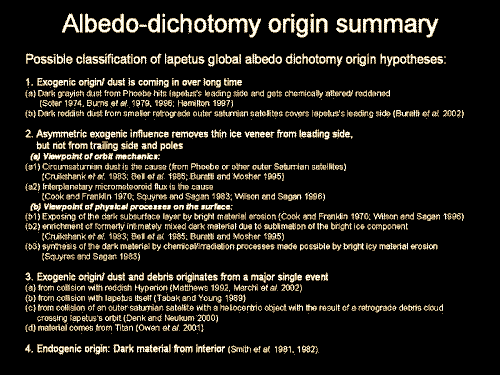
Then (thanks again to Denk - below), there’s
Cassini’s newest,
literally “off the wall” Iapetus discovery … and its associated
“scientific speculations.”

… its origin is a puzzle so far, and no similar geologic feature has
been observed elsewhere in the solar system [emphasis added] ….”
Even so, the usual geological speculations by the Cassini team to
“explain” their suddenly “unique solar system feature” (translation:
“we have no previous experience with whatever this thing is … from
any prior planetary mission … but here’s what we think it might be
anyway …”),
have not been long in coming:
… it is not yet clear whether the ridge is a mountain belt that has
folded upward, or an extensional crack in the surface through which
material from inside Iapetus erupted onto the surface and
accumulated locally, forming the ridge ….”

Translation: “It has to be a mountain range … right?”
But all too soon this official, isolated speculation about the
origin of the “Iapetus Wall” has evolved … into using this “unknown”
in an effort to “explain”
– via additional speculation -- another,
centuries-old “unknown” …
… thus, Cassini Regio [the dark ellipse] may have had its origin in
plume-style eruptions in which dark particulate materials
accumulated on the surface as fallout, perhaps in conjunction with
the creation of the equatorial ridge [emphasis added] ....
So, when critics look with derision on “speculation in science” –
keep in mind that ALL true science begins precisely in such
speculation ... even NASA’s. There are no exceptions. The political
truth is, certain “speculations” re Iapetus are simply on the
“approved list” at this point … and the rest are carefully
“forbidden”—
So, here (below) are some of our own “scientific speculations” on
Iapetus – mixed with some startling new facts.
Enjoy.
OK, let’s begin with the big one: what the hell is Iapetus!?
Actually, it’s easier to begin with what it’s not: apparently, a
natural untouched moon ….
The best evidence for this extremely controversial assertion is
NASA’s own imagery and measurements. Natural planetary objects do
not come with “edges and facets’ – as is indirectly admitted even by
quotes from
the Cassini’s team’s own published papers (below).
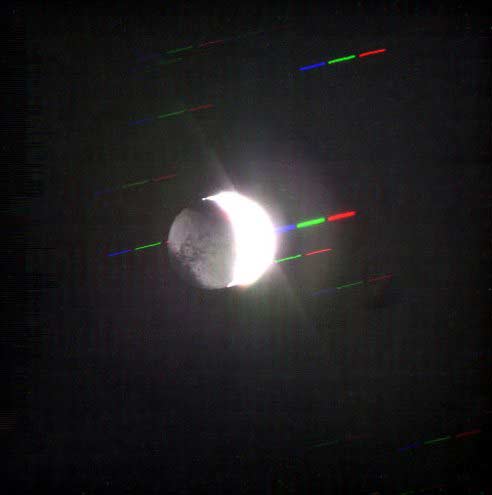
… However, as in Voyager data [8], a good reference ellipsoid cannot
be found because of the unusual irregular shape of Iapetus. A
preliminary, triaxial limb fit result from these and earlier data is
732, 726, and 722 km for three radii [emphasis added] ….
As stated earlier, natural solar system objects larger than about
250 miles across are round!
The physics behind this is very simple:
unless they’re made of high-strength metals (like iron), the
self-gravity of any object composed of ordinary “silicates” (rock)
above a certain size will crush all the “edges” down into a ball.
So, how do we know that Iapetus is not made of such “sterner stuff”
(I mean, some meteorites are iron …), which could then support much
higher, “hundred-mile-long edges” -- even against the 1/40th Earth’s
gravity calculated for its surface?
Simple: spacecraft measurements.
Beginning with the Voyager fly-bys in the 1980’s, and now with
Cassini’s own much closer encounter in December, 2004, the radio
tracking of the spacecraft yielded very accurate measurements of
Iapetus’ gravitational attraction … and hence its mass. This,
divided into the measured volume of the “triaxial ellipsoid” cited
earlier (above), gives us an overall density for Iapetus. And the
density of a natural planetary object is directly related to that
object’s average composition.
Since the density comes out to only about
1.1 grams per cubic
centimeter, Iapetus’ average density is far below that of pure iron
(7.87g/cc). In fact, it’s nowhere close to being even as dense as
stony meteorites (“rocks” -- ~3.5 g/cc) … but is close to pure water
ice (0.91 g/cc) ... with just “a dash of rock” thrown in.
And such a natural “icy object” simply could not sustain (against
its own gravity) the miles-high, angular geometry that NASA itself
has measured for
Iapetus!
Ergo: something MAJOR about Iapetus cannot be natural ….
The next question has to be: exactly what?
The aligned, repeating, rectilinear 3-D geometry we’ve discovered
all across Iapetus’ surface (below) is also foreign to any natural
process … especially on this scale. It also argues forcefully in
favor of some kind of “outside, artificial agency” – which has
heavily modified this “moon.”
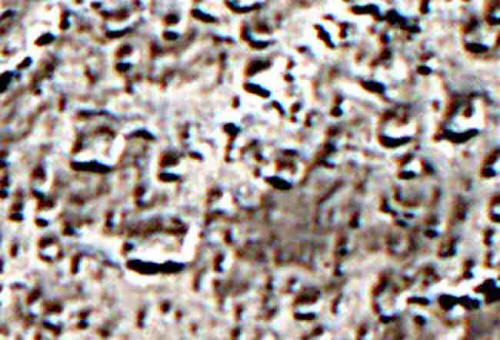
The easiest explanation for all this – after you throw away
“geology” -- is that someone visited Iapetus a long, long time ago
(according to the count of impact craters …), and left some
remarkable structures on its surface. Then, after literally eons,
Cassini finally arrived … to photograph the ruins.
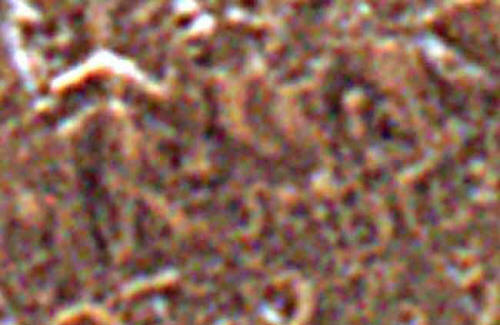
There are several problems with this theory, beginning with equating
the great number of craters visible within Iapetus’ “dark ellipse”
(below) with an actual “great age.”
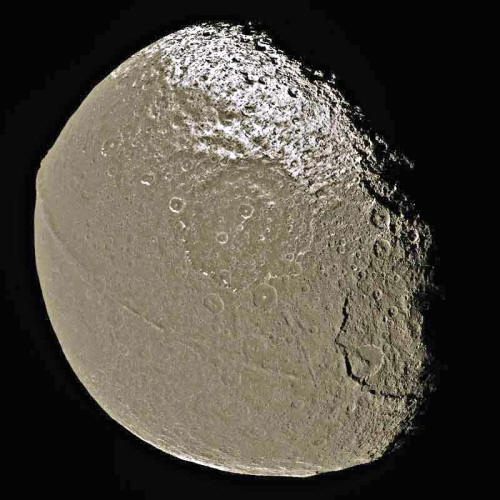
Traditional dating of planetary surfaces relies on “crater counts”
to determine relative regional ages; the more craters a given
surface manifests in spacecraft images (above), the older it is
assumed that surface has to be ….
This results in a set of graphs (below), counting impact craters of
ascending diameters, on a variety of surfaces across the solar
system – beginning with the Moon – and deriving provisional ages of
those surfaces based on the planets’ mass, their position in the
solar system, and the estimated populations of potential impactors
in that region of the solar system.
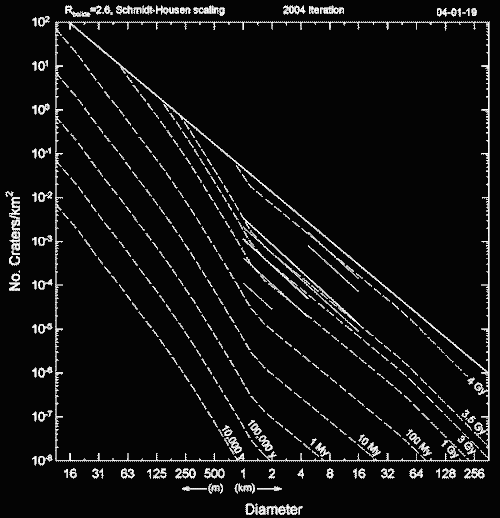
The only actually calibrated cratering data comes from those >
30-year-old Apollo landings on the Moon -- and the astronaut
retrieval and return to Earth of the priceless lunar samples
(augmented by
several Soviet robotic Luna sample return missions).
Careful radiometric measurements of radioactive isotopes (and their
“daughter products”) in the various rocks returned from those Apollo
and Soviet Missions have allowed provisional “real’ ages to be
attached to key lunar crater populations – establishing the closest
thing to an “absolute chronology” for solar system cratering events
we currently possess.
All other “surface ages” in the solar system – from Mercury to the
airless moons of Neptune -- given that we have no “ground truth
samples” from any other body – are ultimately derived from that
calibrated cratering chronology … first established for the Moon.
Obviously, given that the distant environment of Saturn is a vastly
different region of the solar system than the space surrounding
Earth -- almost a billion miles further from the Sun, and with moons
of different composition -- this “calibration” can at best only be
approximate.
But, worse, it has operated under a defining assumption for over
thirty years – that this wide-spread evidence of extensive cratering
-- from the planet Mercury to the moons of the outer solar system --
is due to a single episode of “late heavy bombardment,” from a then
newly-formed population of asteroids and comets “in the beginning” –
debris literally left over from the solar system’s nebula formation,
4.5 billion years ago ....
And that this impacting population -- after initially, steeply,
declining -- has been almost constant (or very gradually waning …)
over the ensuing billions of years (below) ….
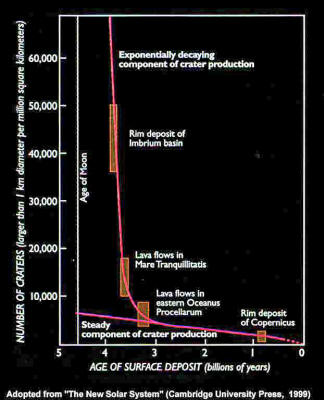
Thus, if a given planetary surface exhibits a “shoulder-to-shoulder”
crater population (like the center of Iapetus’s “dark ellipse” -
below), if it hasn’t been “resurfaced” by obvious internal lava
flows (which Iapetus hasn’t) -- it is automatically assumed that
particular planetary surface must be very, very old … potentially
dating back literally billions of years … to that “late heavy
bombardment” period at the tail end of the actual formation of the
solar system.

That overriding NASA assumption, of that last thirty or so years, is
now quite likely to be very, very wrong …. Because--
A remarkable alternative to this idea was proposed -- over those
same thirty years -- by a scientific “renegade,” a world-class
expert in solar system celestial mechanics: former Head of the
Celestial Mechanics Branch of the U.S. Naval Observatory in
Washington, D.C.,
Dr. Tom Van Flandern.
Van Flandern found – and published in peer-reviewed scientific
journals over those same three decades – compelling evidence of a
very different solar system. One filled with a history of the
semi-periodic, catastrophic destruction of whole worlds ... and the
creation of vast clouds of orbiting debris … which ultimately wind
up hitting all the other planets (and their moons).
If
Van Flandern’s theory is correct, then the carefully calibrated
official cratering graph (above) -- featuring one, intensive,
initial period of nebular debris bombardment … followed by a vastly
reduced number of ever smaller collisions over the ensuing aeons—
Is completely wrong!
Instead, in Van Flandern’s reconstructions, as several successive
planets (of a significantly
more populated former solar system)
literally explode (!) and spread their shrapnel far and wide –
separated by hundreds of millions of years between explosions –
successive “waves” of impacting debris repeatedly collide with all
the remaining planets and their satellites, to leave a highly
intermittent record of overlapping destruction and catastrophe …
which is still on-going.
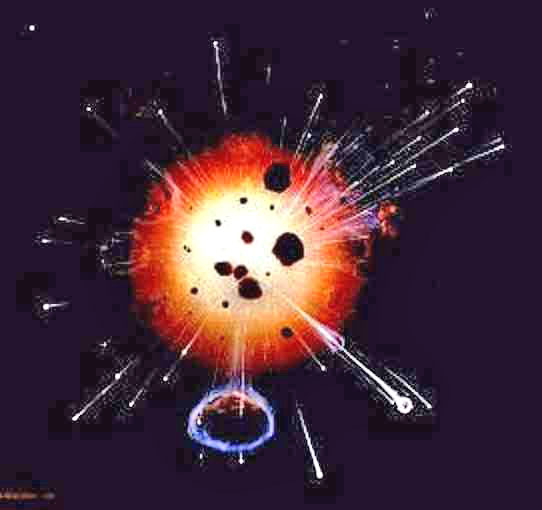
In the mode that “all true science begins with successful
predictions,
” Van Flandern made one particularly intriguing forecast
several years ago in support of the “exploded planet hypothesis
[EPH].”
In
Van Flandern’s paper (2000), he makes the following
statement vis a vis Iapetus:

As can be seen in this “gridded” Cassini image from
December 8, 2004
(below), Tom’s predictions in the case of the EPH and Iapetus were
NOT specifically fulfilled; the distinctly elliptical geometry of
“Cassini Regio” does NOT conform to his simplified “dark half moon”
model (above – left).
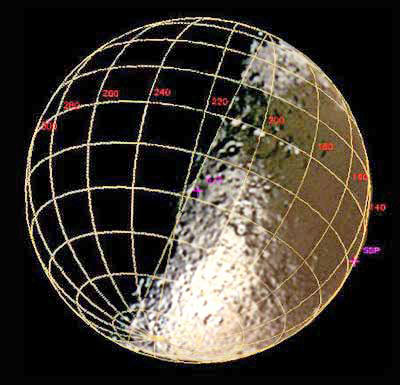
Some may view this as a major failure of Van Flandern’s model. I
don’t – for detailed reasons I’ll go into in a bit. For now, based
on our own subsequent discovery of completely independent evidence
for EPH (subsequent to Van Flandern’s published “Iapetus test” in
2000), this apparent “EPH failure at Iapetus” is actually due to an
oversimplified model for the interaction of such explosion debris
from Planet V with Iapetus itself… rather than an intrinsic failure
of the EPH.
(Incidentally, this is the key reason why there can be no single “up
or down” test for any scientific model … not even the possibility
that Iapetus could be a “spaceship moon” …. Decisions on whether or
not a given hypothesis represents “reality” must be based on the
outcome of a range of careful observations and predictions ... as we
all, at some point, suffer a “failure of imagination” regarding just
how subtle Nature can appear. As someone noted, “the devil is in the
details” ….)
That being said, how does the EPH model impact (sorry …) our
previously stated puzzle: ascertaining the true age of Iapetus, by
counting the number of craters on its surface …? Obviously, if the
EPH is true -- then the “wall-to-wall” cratering observed in the
Cassini imaging (below) – contrary to many recent comments on the
Internet – CANNOT reflect the true “NASA age” of this amazing
“moon.”
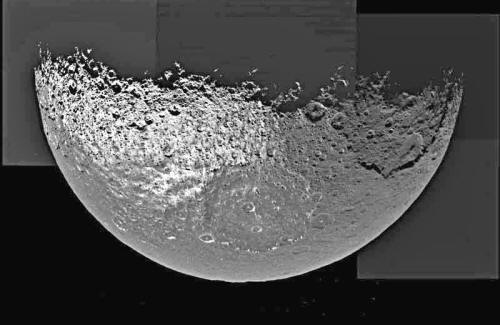
One thing is very obvious: regardless of “when” it happened,
something repeatedly battered the hell out of this unique Saturnian
“moon!”
Which brings us back to the question we posed earlier: if major
aspects of this object – its shape, the “wall,” the astonishing
surface geometry, etc. -- are increasingly difficult to explain away
“geologically” … then just what is Iapetus: a modified natural
satellite of Saturn … or even, a completely artificial “moon?”
The prime reason I cannot believe that the geometry we now see all
across the surface of Iapetus represents mere “surface
installations” comes down to essentially one word: gravity.
Iapetus, with a
gravitational attraction 1/40th that of Earth (1/7th
our own Moon), simply cannot hold any reasonable atmosphere for any
length of time. That would make the extensive geometry (“surface
constructions”) as we see on Iapetus totally impractical … as former
surface habitations.
This concept of “retainable atmospheres” is not new in astrophysics;
Sir James Jeans was calculating and writing about planetary and
satellite atmospheric escape rates in the early 20th Century, using
the newly-discovered atmosphere of distant, low-mass Titan (in 1908)
as theoretical confirmation of his calculations regarding how a
planet’s/moon’s atmospheric temperature (which determines the
average speed of gaseous molecules and atoms – below – depending on
their mass), coupled with its escape velocity (related to surface
gravity),
determine how long such atmospheres can be retained. His
classic work, augmented by more recent calculations and observations
regarding how the energetic magnetospheres of the giant planets
(like Saturn) can
sweep atmospheres from their low-mass satellites
away into space, made it quite clear that no one would have ever
created extensive habitations on Iapetus’ surface.

However, if the geometry we see on Iapetus’ was part of the remains
of former underground installations … revealed through either
catastrophic bombardment, or a much longer age of meteor erosion of
overlying surface layering ... then the whole idea of Ipaetus as
some kind of “space base” -- or even a designed “moon-sized space
station” -- began to make more sense.
It was after analyzing these atmospheric rates, and the startling
new images presented by Cassini – especially, Iapetus’ bizarre
geometric shape – that I came to the provisional conclusion that
Iapetus had not been “built upon” … so much as it had to be
carefully designed!
And, a lot has happened to “the neighborhood” since that occurred ….
The second major clue in favor of this radical idea was the orbit of
Iapetus.
All the other “regular” moons – from little Mimas (~250 mile
diameter) to Titan (~3200 miles across) – orbit in the plane of
Saturn’s equator, along with the trillions of particles making up
the rings (below).

Iapetus is different. Though the third largest satellite (after
Titan) -- at slightly over 900 miles across -- as noted earlier,
Iapetus orbits significantly inclined to the rest of Saturn’s moons
(below) – at some ~15 degrees … and over 2 million miles (~ 60
Saturn radii) away.

Flattened “nebular models” for both the swirling condensation of the
solar system from an original cloud of interstellar gas and dust --
as well as the condensation of the major planets within that
flattened nebula (below) -- have difficulty with high inclination
orbits; frictional forces and mutual gravitational encounters should
“warp” the orbits of forming planets and/or satellites down
into the
general plane of all the other forming objects, even before they’re
fully formed ….
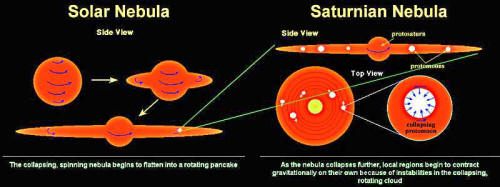
The high orbital inclination of the third largest moon in the Saturn
system … and in the outer regions of its proto-nebula … presents a
fundamental “problem” for this simple picture. One way around this
problem is to explain the “anomaly” as due to “a catastrophic
collision/interaction with another proto-moon” as Iapetus was
forming. However, this is an “ad hoc” solution -- born of a lack (in
the strictly natural paradigm) of any viable alternative ….
Once the (amazing) possibility is admitted that Iapetus could be an
artificial “moon” – and may have been deliberately inserted into
such an odd orbit – the “coincidental” nature of its unique, steep
inclination (relative to the other similar-sized Saturnian moons --
Dione, Rhea, etc.) goes away.
But, equally “coincidental” is the shape of Iapetus’ inclined orbit
… and its precise distance from Saturn.
Iapetus’ orbit is extremely close to being circular -- with an
eccentricity of only 0.0283 – departing from a perfect circle by
slightly less than 3%. (By comparison, our Moon’s orbital
eccentricity – a body that mainstream planetologists now propose was
born from a similar theorized “collision”
– is 0.0549 or ~ 6% …
essentially twice as eccentric as
Iapetus!)
For an almost circular, very high inclination orbit to have formed
through “random chance” is really pushing coincidence -- if the
agent for achieving that low eccentricity and the high inclination
is supposed to be the same “random” collisional event, back when
Iapetus was forming.
And, there’s more.
The sharp reader will have noticed, from
the preceding references,
that Iapetus currently orbits slightly less than 60 radii away from
Saturn (59.091 radii, to be exact - below). This discrepancy, 0.15%
-- in the artificial model that precisely 60 radii was originally
intended -- would represent how much Iapetus has drifted since it
was “parked” (as a designed “station”) in Saturn orbit. That rate of
drift, either due to Saturnian/sun tides, or other forces (to be
discussed in detail later), could give another way to estimate –
other than by counting craters – roughly “when” this entire scenario
in fact occurred ….
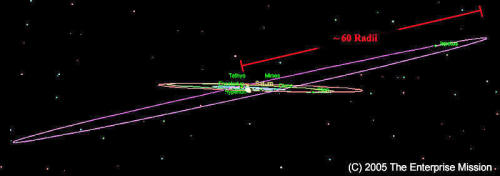
That “ideal” Iapetus distance from Saturn just “happens” to also be
base 60 -- another tetrahedral number -- suddenly appearing in the
first Sumerian civilization on Earth some ~ 6000 years ago …. A
number that fits perfectly into the redundant, equally mysterious
tetrahedral placement of the two major “ring basins” we’ve
previously discussed on Iapetus … 120/240 degrees apart.
And, the same number that is also redundantly communicated via
Iapetus’ own baffling Platonic shape!
Which leads us to another startling “coincidence.”
If you take the inclination of Iapetus’ orbit (~ 15 degrees) and
multiply by its distance in Saturn radii (60), the result is the
average of the current Cassini “triaxial measurements” of Iapetus’
diameter (below)—
~ 900 miles!
The measured Iapetus’ diameter!!
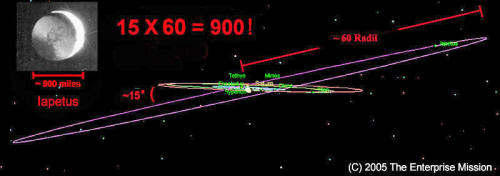
(The slight discrepancies between the “ideal numbers,” and those
currently observed, can easily be explained as slight changes –
occurring over a literally geological period of time – in the
evolving orbital elements of Iapetus … again, due to external solar
system forces.)
All these numbers – Iapetus’ size, distance from Saturn, and orbital
inclination -- are “independent variables.” Meaning – none of them
are automatically interrelated, or mandated by any current theory of
satellite formation. Yet, for some reason, they have all come
together in Iapetus … this one bizarre “moon” … orbiting Saturn.
This simply makes no sense, and the odds of it happening
coincidentally – especially, resulting in the actual diameter of
Iapetus expressed in miles! -- are (really!) “astronomical”—
Unless this was designed!
Now, if Iapetus was created (literally, “from the ground up”) -- to
memorialize “something” extremely valuable and historically
important -- both its size and orbital elements could easily have
been precisely engineered … as recurring aspects of the same
“tetrahedral message” embodied in other aspects of this satellite …
a much vaster variant on our previously discovered (and deciphered)
tetrahedral “Message of Cydonia.”
Curiously, if you again take that orbital inclination of Iapetus in
degrees (~ 15), and divide it into the ~ 60 Saturn radii of its
orbit, the result is 4 … the number of the very planet where we
found our first extraterrestrial “tetrahedral” design.
In other words, is Iapetus actually a time capsule -- with its own
haunting, multi-leveled Message? A message ultimately ending with
(below):
“Mars is where our solar-system-wide civilization was centered … and
where its shattering demise began …?”

Regardless of the details, the point of such an elaborate,
redundantly encoded communication – if it is “communication” --
could only be to signal the presence of vital information on/in
Iapetus regarding its strange presence in the Saturn system … to
whoever discovered this unique “moon” when they finally developed
(redeveloped?) the technology able to reach Saturn once again!
But, a signal that would only be successful if those reaching it
this time understood the crucial, ancient “code key” of
hyperdimensional physics: base 60. Which, among other essentials,
includes the non-arbitrary, elemental reason for a “360-degree
circle” … and the size of the British mile … based on sexagesimal
“tetrahedral geometry” itself.
Ok, you now see where I’m going ….
In the “spaceship moon model” for Iapetus -- leaving aside for the
moment the non-trivial reasons for building such a stupendous
“craft” -- there are only two possible points of origin:
1) a “vehicle” from somewhere, far beyond the solar system … some
kind of “interstellar ark”– which came to this system a long, long
time ago … and ended up at Saturn
2) a spaceship “moon” built
within this solar system, for equally obscure reasons … which also
ended up at Saturn -- but with a visible signature, the baffling
“light/dark dichotomy” -- which would flag it across the entire
system and future millennia as “anomalous” … for the returning
descendents of whoever originally left it circling eternally in
orbit ….
What was it
Goldsmith and Owen said, back in 1980 …?
… the only object in the Solar System which we might seriously
regard as an alien signpost – a natural object deliberately modified
by an advanced civilization to attract our attention [emphasis
added] ….
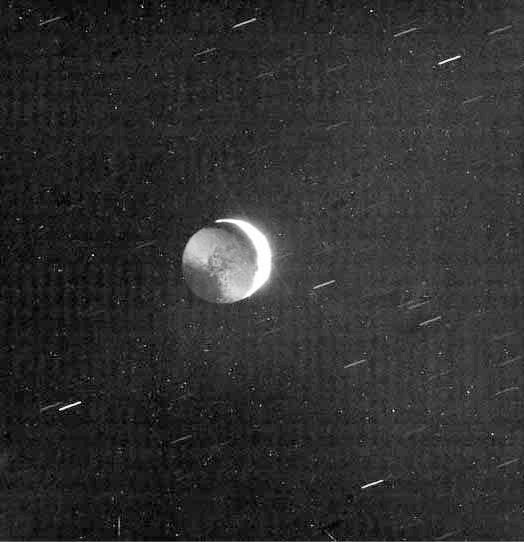
Or, as I noted the other night on “Coast,” it overwhelmingly reminds
me now of that great line from Kirk, in Star Trek IV:
“Ok, everybody … remember where we parked!”
We’ll consider in some detail the “interstellar option” later on.
But for now, what about the “solar system explanation”: if Iapetus
is truly a derelict “spaceship moon” -- who built it, and where
could they have come from … in this system?
In keeping with years of previous research published here on
Enterprise, would it surprise anyone to learn that the answer to
those questions could lead us all the way back across the solar
system … from the distant, icy realm of Saturn … back to—
Mars?
What if (we’re speculating, remember?) … the inconceivable,
increasingly confirmed catastrophe which overtook Planet V – the
last major solar system planet to explode in
the Van Flandern model,
and
the one Mars used to orbit as a moon – was anticipated?! What if
the real science of planetology was able then – utilizing a
sophisticated hyperdimensional model – to be aware of a developing
instability in Planet V’s core … centuries or even millenia before
it was destined to explode?
Faced with such an overwhelming but certain, planet-wide catastrophe
-- what would that incredibly advanced society (judging by the
awesome scale of
the ruins still present on its surface) have done?
If it was discovered that nothing could be accomplished
technologically to prevent such a catastrophic core explosion, the
only reasonable alternative would have been a mass migration of the
Martian population (or, a reasonable fraction thereof …) to another
planet. And one definitely well away from the inner solar system ...
as the effects of the explosion would be felt even billions of miles
away ….
And that would have called for either an interstellar migration to
another solar system, or the terraforming of another planet … in the
outer reaches of this one. Or—
The creation of a totally new “planet!”
So, was Iapetus part of all three options …?
In other words, was Iapetus a specifically designed “interstellar
ark” -- created on a crash basis in the Saturn system (see below) to
transport a significant population from a doomed Mars (if not from
other worlds in the entire imperiled inner solar system!) … to the
stars?
Is that what the “number 4” – indelibly encoded in the very orbit of
Iapetus – is telling us ... across the millions of miles and the
literally millions of years since that inconceivable explosion: that
it all goes back to … Mars!?
Did mass interstellar migration with such a large population turn
out to be impossible, in time … so Iapetus was built as the
“replacement planet” in this system -- for some small percentage of
the teeming populations of those soon to be destroyed inner system
worlds (the Earth, the Moon, Mars …) whose peoples would literally
have no place else to go …?
Was this “ark” (Noah anyone …?) then left in orbit around Saturn …
because – like in the interstellar scenario above -- the Saturn
system was an abundant source of raw materials for its construction,
if not the vital resources needed to sustain a long-term biosphere
for those who would be “saved?” Was Saturn also chosen because it
was far enough from the impending cataclysm to insure survival … yet
still close enough to the warm center of the solar system to allow
the next phase in this extraordinary Plan to be initiated--
The increasingly fascinating enigma of Titan -- as a literal “Saturn
system terraforming project?” A valiant attempt to recreate a whole
new world for the rescued populations of the soon-to-be-destroyed
entire inner solar system … but on an even grander scale …?

Click Here for Part Five
→
|























